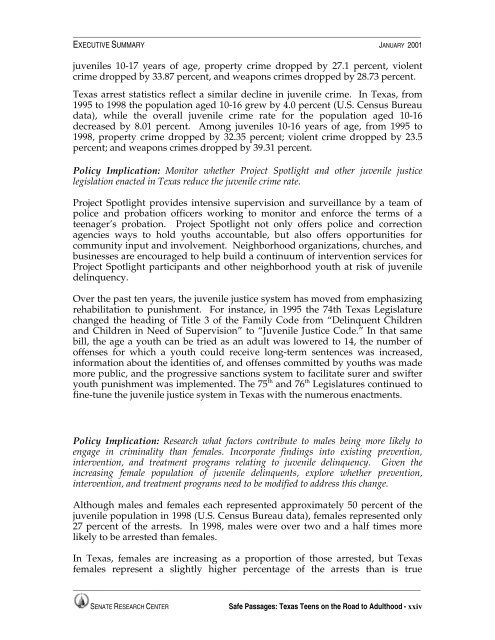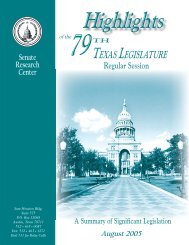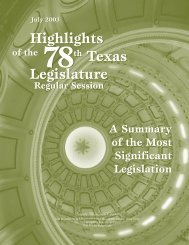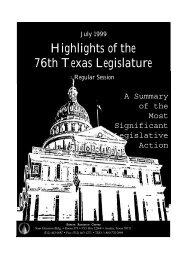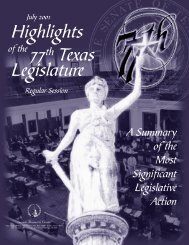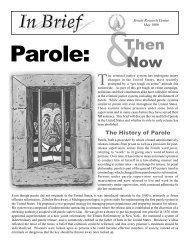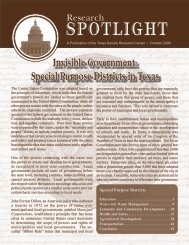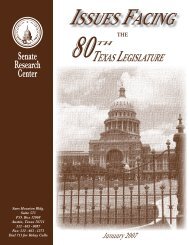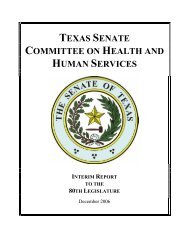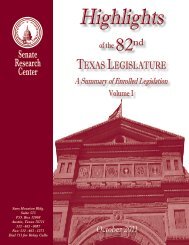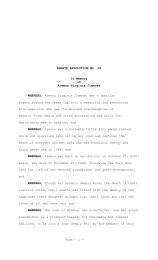Texas Teens Cover - Senate
Texas Teens Cover - Senate
Texas Teens Cover - Senate
Create successful ePaper yourself
Turn your PDF publications into a flip-book with our unique Google optimized e-Paper software.
______________________________________________________________________________________<br />
EXECUTIVE SUMMARY JANUARY 2001<br />
juveniles 10-17 years of age, property crime dropped by 27.1 percent, violent<br />
crime dropped by 33.87 percent, and weapons crimes dropped by 28.73 percent.<br />
<strong>Texas</strong> arrest statistics reflect a similar decline in juvenile crime. In <strong>Texas</strong>, from<br />
1995 to 1998 the population aged 10-16 grew by 4.0 percent (U.S. Census Bureau<br />
data), while the overall juvenile crime rate for the population aged 10-16<br />
decreased by 8.01 percent. Among juveniles 10-16 years of age, from 1995 to<br />
1998, property crime dropped by 32.35 percent; violent crime dropped by 23.5<br />
percent; and weapons crimes dropped by 39.31 percent.<br />
Policy Implication: Monitor whether Project Spotlight and other juvenile justice<br />
legislation enacted in <strong>Texas</strong> reduce the juvenile crime rate.<br />
Project Spotlight provides intensive supervision and surveillance by a team of<br />
police and probation officers working to monitor and enforce the terms of a<br />
teenager’s probation. Project Spotlight not only offers police and correction<br />
agencies ways to hold youths accountable, but also offers opportunities for<br />
community input and involvement. Neighborhood organizations, churches, and<br />
businesses are encouraged to help build a continuum of intervention services for<br />
Project Spotlight participants and other neighborhood youth at risk of juvenile<br />
delinquency.<br />
Over the past ten years, the juvenile justice system has moved from emphasizing<br />
rehabilitation to punishment. For instance, in 1995 the 74th <strong>Texas</strong> Legislature<br />
changed the heading of Title 3 of the Family Code from “Delinquent Children<br />
and Children in Need of Supervision” to “Juvenile Justice Code.” In that same<br />
bill, the age a youth can be tried as an adult was lowered to 14, the number of<br />
offenses for which a youth could receive long-term sentences was increased,<br />
information about the identities of, and offenses committed by youths was made<br />
more public, and the progressive sanctions system to facilitate surer and swifter<br />
youth punishment was implemented. The 75 th and 76 th Legislatures continued to<br />
fine-tune the juvenile justice system in <strong>Texas</strong> with the numerous enactments.<br />
Policy Implication: Research what factors contribute to males being more likely to<br />
engage in criminality than females. Incorporate findings into existing prevention,<br />
intervention, and treatment programs relating to juvenile delinquency. Given the<br />
increasing female population of juvenile delinquents, explore whether prevention,<br />
intervention, and treatment programs need to be modified to address this change.<br />
Although males and females each represented approximately 50 percent of the<br />
juvenile population in 1998 (U.S. Census Bureau data), females represented only<br />
27 percent of the arrests. In 1998, males were over two and a half times more<br />
likely to be arrested than females.<br />
In <strong>Texas</strong>, females are increasing as a proportion of those arrested, but <strong>Texas</strong><br />
females represent a slightly higher percentage of the arrests than is true<br />
______________________________________________________________________________________<br />
SENATE RESEARCH CENTER<br />
Safe Passages: <strong>Texas</strong> <strong>Teens</strong> on the Road to Adulthood - xxiv


